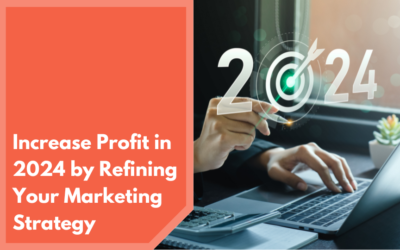The development of a high-converting website is not an accident. And it is not out of reach. It may be interesting to consider that one of the greatest barriers to developing a great website that converts is that you may be too close to the details of your company. That’s right. You may not have the distance necessary to see what is really great about you. Or how to best describe your products and services in a way that resonates with and motives your target audience to take the next step. To help them choose to take action.
Here are some ideas that you can implement right now or as you develop your next website.
Define Your Target Markets. Most businesses have several market segments they could target. You’d want to make these groupings based on characteristics, similarity of needs, of behavior, or any other factor that would make them discrete and different from the other groups. For example, your target markets could be based on industries or they could be based on the lifecycle stage of your customers. Once you have these groupings, you will want to prioritize them based on opportunity, and then focus on just a few.
Write to Representative Personas. Once you have selected your target market segments, you will want to develop ‘personas’ for each. A persona is simply a fleshed out description of a person that is representative of that target segment. In large companies with huge budgets, this can get quite sophisticated. But it doesn’t have to be; it simply has to be at a level of detail that you now can ‘speak’ to that person in a conversational tone that will make sense to them. The persona is a way for you to be able to engage in a livelier or meaningful way with your audience. Your communication becomes more one-on-one, and your message will be richer in tone.
Communicate What Differentiates You From Competition. An important exercise prior to developing your website, during your strategy phase, is to spend time thinking about the question, “Why should someone choose to do business with me”? For many businesses, this is a very difficult question to answer. Again, being too close to the business may give you blind spot as to how you compare to other alternatives. Asking your customers is a great way to learn about what you do well (and why it matters), and can help you gain the clarity of your differentiating factors. Once you know what’s different about you, weave that information consistently through your content.
Don’t Buck Convention. However, don’t go overboard in trying to be different. Sometimes companies fall into the trap of wanting to make every aspect of their website different. Don’t fall into that trap. Why? When your prospective customers come to their website, if you don’t rely on convention, you will cause them cognitive overload. They will spend an inordinate amount of time learning how to navigate your website vs absorbing your content. So you’ll want to rely on a lot of the standards that have developed over time with regard to your website layout, information architecture, user interface design, etc. So be different in some ways, but just not too different as to be distracting.
Develop an Information Architecture That Makes Sense. Related to the above, one of the first tasks after you develop your website strategy and goals is to develop an appropriate information architecture. This is where you start tying in the needs of your target market segments, customized for the personas you’ve developed previously. What do people need to see, and in what order do they need to see it? What is the purchasing process, and how are decisions made for your product or service? How are the needs different for new and returning customers? Pose questions like these to help you think through the structure that will support the needs of your audience.
Each Page Should Stand on Its Own AND Interrelate Appropriately. Many people will not look at every page of your website. In fact, many will not enter through the home page, particularly if you engage in marketing, including SEO and paid search. Each page must stand on its own. Each page must tell the logical ‘conversion story’ that leads visitors through a decision to choose you. So the ‘who, what, where, when, why and how’ must be addressed. As you are developing the proper structure for your pages, be sure to chunk the information. Ideally, you’d want someone to be able to just read the subheadlines to get the cliff notes version of the page. Don’t worry, if a section is of interest, most visitors will stop and read the details. And some buyers, in a hurry, may just get the gist through the chunks and go on to buy.
Focus on Benefits, Not Just Features. This is a classic issue that can be addressed with good marketing. You’ve heard it said, “A person doesn’t buy the drill, he buys the hole it makes.” Same with your product or service. It is fine to list the features, but know that is not what people buy. They buy the benefits derived from those features, so make sure this information is visible and well-articulated.
Ask For the Sale. When you have told your conversion story on any given page, ask for the sale. And the sale isn’t always ‘buy’ – it may also be a next step in a process. Download the white paper. Read the specifications. What is important is that you are clear about what the next step in the purchase process should be, and that next step should be made abundantly clear on your page. As a side note, if you have a long content page, you may want to offer the next step or ask for the sale at various points on the page. Since all buyers are different, and need different amounts of information, there is nothing wrong with asking for the sale above the fold, further down, and then at the bottom of the page. As long as these exit opportunities are appropriately placed, they will increase your conversion rate.
Take Advantage of the ‘Seducible Moment.’ Think about it. If you have a reasonable amount of content, there will be some scrolling and some investment on the part of the visitors who get to the bottom of the page. This means that the bottom of the page is a very special moment, and actually an intimate moment, where the visitor is poised between leaving your site, going to start another page, or… taking the desired action. This point has been called the ‘seducible moment’ because in that moment of decision, you have an extraordinary opportunity to do your best work in getting the visitor to convert. Go for it!
Don’t Forget the Thank You Page. And don’t forget to say ‘thank you.’ Once some action is taken that yields a thank you page, take full advantage of this page. Think about it. Friction has been reduced, now that a decision has been taken and the deed is done. This is the mindset of your visitor. This is a perfect time to give them some extra goodies to really cement goodwill, to reassure them of their decision, to give them new conversion opportunities. A myriad of options. What is the best one for your visitors?
In the end, the marketing message is always ‘local’… You are speaking to a person, and that person votes on your effectiveness with a click of their mouse. These tips can help you make that connection.
If you are looking for help in amplifying your message in a way that connects, call us. DirectiveGroup has deep expertise in developing websites that convert. We’ll be worth your investment.





